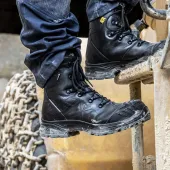Protecting Employee Health

First published in the March 2014 issue of Quarry Management
An increasing number of mining and quarrying businesses are recognizing that they can both comply with legislation and improve their productivity and profitability by using sampling pumps, a valuable tool with which to protect employee health, says Neal Hill.
In the quarrying industry, sustained exposure to fine, respirable dust created when undertaking heavy industrial processes such as drilling and blasting poses a particular risk to human health. However, respirable dust, which is the most harmful size fraction, is not visible to the naked eye and workers are all too often unaware that this type of exposure poses a problem.
To protect workers from this hidden threat, many industry bodies have conducted research and proposed change. In 2013, the TUC proposed that occupational health should have the same priority as injury prevention measures. The TUC backed up this proposal with the estimate that diseases caused through occupational exposure kill six times more employees than work-related accidents. The estimated direct and indirect costs of this equate to around 4% of global GDP, according to the ILO (International Labour Organization).
The first and last priority of safety procedure is to protect employees, but good safety practice also protects profitability. When work days are lost due to workplace injury or work-related illness, the plant suffers reduced productivity, which affects everyone.
Most industrial and manufacturing companies have embraced health and safety as an established part of their business processes. Yet, all too often, health and safety practices are based on a simple assessment of risk, with accident prevention measures and basic employee training being the only initiatives that are put in place. Although this approach complies with legislation it is often based on a premise that health and safety rules are a necessary encumbrance to a business, rather than essential measures that should be reviewed, enhanced and maybe even exceeded.
In contrast, more enlightened companies are recognizing that by aiming high when it comes to health and safety, they can both comply with legislation and improve their productivity and profitability. From an operational point of view, this might include a change in machine maintenance and repair techniques, or controlling the issue of the correct equipment. It may involve selection of exactly the right hearing protection or identification of the best respiratory protection for different tasks to reduce fatigue and personal injury. Personal protective equipment (PPE) can improve an employee’s ability to concentrate and work effectively, while a poor specification can have the opposite effect, especially if these items must be worn simultaneously but are incompatible.
Monitoring exposure
In addition to protective clothing and accessories, safety in the engineering workplace can be strongly supported by exposure-monitoring tools. Increasingly, in harsh environments such as quarrying and mining, this includes personal air-sampling pumps that monitor the presence of harmful dusts in the atmosphere.
The proliferation of sampling pumps has been fuelled by increasing evidence that diseases caused by dusts and fumes are a serious threat. The British Occupational Hygiene Society (BOHS), the chartered society for worker health protection, has highlighted new scientific evidence which indicates that a group of potentially life-threatening lung diseases, known collectively as chronic obstructive pulmonary disease (COPD), are caused by a wide range of dusts and fumes found across many industrial sectors.
COPD is an umbrella term used to describe a number of lung diseases that make breathing difficult, such as chronic bronchitis and emphysema. In cases of COPD, the lungs and their breathing tubes sustain serious long-term damage, making it difficult to get air in and out, and causing many ordinary activities, such as walking up a hill, to become difficult because of shortness of breath.
‘For some time, it has been well known that breathing in certain dusts and fumes in the workplace, such as coal dusts and welding fumes, can cause COPD,’ reported BOHS in January 2014. However, a new study, published in the Scandinavian Journal of Work, Environment and Health, has identified an extensive range of agents, found across many industrial sectors, as risk factors for COPD. The identified agents include welding fumes, coke dust, coal, asphalt, silica, cement, tunnel dust, cadmium, dust in glass bangle manufacture, bleach, cotton, flax, jute, farming dusts, grain, wood, rubber and endotoxins. The research found consistent associations between workplace exposures and COPD across a wide range of sectors, with the authors of the study describing a ‘nearly uniform pattern’ of exposure–response relationships.
The designers and engineers behind instrumentation for health and safety have been working to provide adequate solutions that companies can use to protect employees from dusts and fumes, but the technology is not new. Sixty years ago Casella developed the first sampling pump for use in coal mines, and their TUFF personal sampling pump has all the necessary certifications to meet The Coal Mines (Control of Inhalable Dust) Regulations 2007. The pump was the only product of its kind in the world certified to M1 intrinsically safe (IS) rating when the British coal mining industry wanted to trial Casella’s TUFF pump.
In addition to its certification for use in potentially hazardous atmospheres due to flammable gases or dusts, the IS TUFF pump offers the reliability that is essential in health and safety equipment, not least because of what it offers in terms of battery management. Built to withstand harsh environmental conditions, the pump’s intelligent battery monitoring and fast/trickle charge control facility maintain optimum battery condition and service life, while fast charging and a remaining run time ‘fuel gauge’ help ensure availability. For site operators and managers who have a requirement for area monitoring, real-time monitoring options, such as Casella’s Dust Detective, offer an effective, quick-to-assemble survey tool, providing data that can be downloaded for evaluation and reporting purposes. The unit uses a Microdust Pro real-time dust monitor, TUFF air-sampling pump and operates off internal batteries for up to 13h.
Sampling pumps have become a valuable tool with which to protect health in mines and quarries. The best of today’s models feature easy-to-use displays with high-intensity LED alarms for fault indication, with exceptional flow rates and precise digital control. Pumps are also available that feature an extremely robust, rubber over-moulded unit designed specifically for use in harsh monitoring environments, offering excellent functionality and long service life at a cost-effective price.
The move towards tougher protection and monitoring when it comes to dusts and gases has become an established part of the business processes for most industrial and manufacturing companies. It has moved beyond a simple assessment of risk to comply with and exceed the requirements of legislation, and the welcome growth of this more responsible culture will make it easier for most firms to adjust. Indeed, the more enlightened companies are already recognizing that by getting in line with legislation as early as possible, they can both comply with legislation and improve their productivity and profitability.
For further information visit: www.casellameasurement.com
-
Subscribe to Quarry Management, the monthly journal for the mineral products industry, to read articles before they appear on Agg-Net








